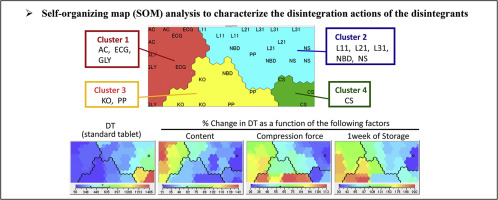To gain a better understanding of disintegration actions, 11 different disintegrants were tested. Model tablets were prepared with various preparation conditions, and their disintegration time and tensile strength were measured. The present study also investigated various physicochemical properties of the model tablets and disintegrant powders, including wetting time, water absorption ratio, particle size, morphological observation, swelling property, and T2 relaxation time (T2). The experimental data were thoroughly analyzed using self-organizing map (SOM) clustering. The test disintegrants were classified into four distinct clusters. It is worth noting that superdisintegrants, including croscarmellose sodium (Ac-Di-Sol), sodium starch glycolate (Glycolys), and crospovidone (Kollidone CL-F and Polyplasdon XL-10), were assigned to clusters different from those of normal disintegrants. Furthermore, SOM clustering suggested the latent contributions of factors to the disintegration actions. The disintegrant content had a significant impact on the disintegration actions. Furthermore, the T2 measurements indicated that the interaction mode of crospovidone with water was different from those of cellulose- and starch-based disintegrants. The evidence obtained is valuable information for the formulation design of tablets.
Journal of Drug Delivery Science and Technology
http://www.sciencedirect.com/science/article/pii/S1773224717307281

